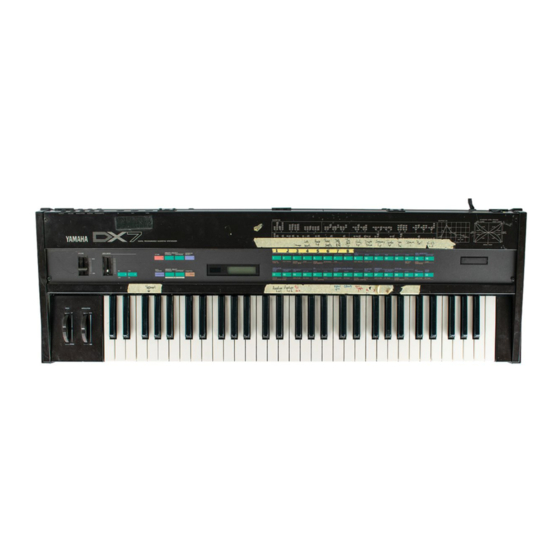
Table of Contents
Advertisement
Quick Links
Yamaha DX7mega128 Expansion User Guide
1: Introduction
1
The DX7mega128
is essentially a "lite" DX7 SuperMAX+ type expansion. It provides the
following new features:
MEMORY EXPANSION
4x memory expansion: There are now 128 patches
arranged in 4 banks of 32. Each patch is directly selectable by standard MIDI Patch
Change messages.
The Function Settings can be saved as a single global value or on a per-patch basis.
GLOBAL PARAMETERS
MIDI Transmit Channel: You can set the MIDI OUT channel from 1 to 16. (MIDI IN is
already settable in the Yamaha factory DX7 v1.8 firmware using button Function 8).
Local On/Off: You can set whether the local keyboard sounds the internal FM sound
engine (or not).
MIDI Receive in OMNI mode (receives on any/all channels).
PATCH PARAMETERS
Programmable Keyboard Zone: Each patch can utilize a settable active keyboard zone
(low key to high key) within which the local keyboard sounds the internal FM sound
engine per patch.
Programmable Patch Volume: Each patch can utilize a volume to even out the DX7
levels when changing patches.
Voice Stacking: You can stack and detune two or four voices of the same patch. You
then have a choice of 16x1, 8x2, or 4x4 polyphony. The detuning can provide chorus
effect and/or chording and/or octaves (for example).
BUG FIXES
Includes the fixes for the DX7 Fixed Frequency table bug and also includes the faster
boot.
[v1.30+] Hardware-selectable MIDI Velocity Offset fixes the stock DX7 velocity issue.
1
The information provided in this document is intended for informational purposes only and is subject to
change without notice. Information may be changed or updated without notice. We may also make
improvements and/or changes in the product(s) described in this information at any time.
2
In this document the term "patch" is used to denote a programmed sound. For some unknown reason back
in the 80's, Yamaha called these "voices". The typical use for "voices" these days is to indicate the degree
of polyphony (how many keys you can hold down at once and get sound for).
DX7mega128
*
Welcome to
*
DX7mega128
Page 1 of 8
www.musictechnologiesgroup.com
*
*
2
(what Yamaha calls "voices")
User Guide v1.30
Preliminary
Advertisement
Table of Contents

Summary of Contents for Yamaha DX7mega128
- Page 1 In this document the term "patch" is used to denote a programmed sound. For some unknown reason back in the 80's, Yamaha called these "voices". The typical use for "voices" these days is to indicate the degree of polyphony (how many keys you can hold down at once and get sound for).
- Page 2 AND THIS: CAN CHANGE Version Check You can check the version of your DX7mega128 by pressing the brown FUNCTION key and while holding it down press and hold 16 and 32. You should see a version message such as: DX7mega128 Version 1.20...
-
Page 3: Recommended Initialization
Steps 1 and 5 are standard DX7 user manual stuff. For the other steps you need to read this entire manual anyway, so take the time to do that and make note of how to perform steps 2, 3 and 4. And if you haven’t read the Yamaha DX7 user manual, well … consider it. DX7mega128 Page 3 of 8 User Guide v1.30... -
Page 4: Operation
FUNCTION CONTROL KB Zone Lo = C1 FUNCTION CONTROL KB Zone Hi = C6 FUNCTION CONTROL Voice Stack= 2x8 FUNCTION CONTROL Detune Coarse… FUNCTION CONTROL Detune Fine… DX7mega128 Page 4 of 8 User Guide v1.30 www.musictechnologiesgroup.com Preliminary... -
Page 5: Memory Bank Selection
Recall that the DX7 has 32 internal patches accessed by pressing the INTERNAL button and then one of the patch numbers 1 though 32. The DX7mega128 has four banks of these to make the 128 patches: Bank 1 Patches 1 to 32 MIDI patch numbers 1 to 32. - Page 6 Using the Data slider or the Yes/No buttons, select the MIDI OUT channel you want, the range is 1 to 16. Note: The MIDI IN channel is established via the standard DX7 Function button 8. DX7mega128 Page 6 of 8 User Guide v1.30 www.musictechnologiesgroup.com...
- Page 7 The last three screens are used to set the Voice stacking mode and detuning of the extra voices. DX7mega128 allows you to stack a DX7 patch in modes of 16x1 (standard, no stacking), 8x2 or 4x4. Each of the extra voices can have its pitch offset. Thus you can create not only chorus/flange type effects, but also octave and chording.
- Page 8 127 ($7F hex) without fear of damaging the keybed. The DX7mega128 circuit board has a switch, S1, that allows you to change between default (0) and full velocity (+3) operation. This switch is not intended to be changed on-the-fly with the power on, but you can try it for an A:B comparison if your patches are backed up.









